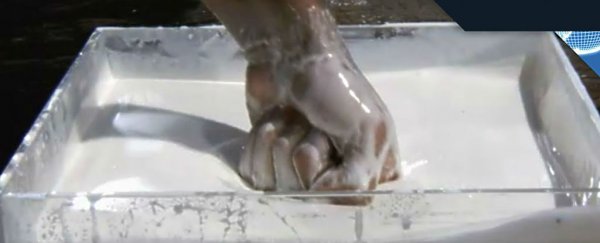If you've ever seen a non-Newtonian fluid in action, you'll know how impossibly cool it is. It changes its viscosity almost instantly under stress, so you can punch it as a liquid and it'll turn into a solid, and you can literally walk across a pool of it, which looks amazing btw.
While physicists have understood the gist of how non-Newtonian fluid can change states from a liquid to a solid depending on how you manipulate it, warring parties have been at odds over what's going on at a molecular level - what exactly are those particles doing in there to make a substance so strange?
It's been decades, but now a new paper has come out with a potential solution, and it turns out the answer is… everyone's right!
But let's back up a bit and run through some of the basics. First off: what exactly is a non-Newtonian fluid? Well, as its name suggests, it's the exact opposite of a Newtonian fluid.
A Newtonian fluid is easy - it's defined by Newton as the perfect fluid, where its viscosity is influenced mostly by its temperature and pressure. So if you have water at a moderate temperature and pressure, it will continue to act like a liquid no matter how much you punch it.
Non-Newtonian fluids, on the other hand, follow a different set of rules. You just need to exert some kind of force on it - like a punch - and it'll change its viscosity in such a way that it can shift its states entirely.
The key to viscosity is how much friction or resistance a substance has, for example, honey is very viscous, while water is not.
As Jennifer Ouellette wrtites over at io9:
"The friction arises because a flowing liquid is essentially a series of layers sliding past one another. The faster one layer slides over another, the more resistance there is, and the slower one layer slides over another, the less resistance there is. Anyone who's ever stuck their arm out of the window of a moving car can attest that there is more air resistance the faster the car is moving (air is technically a fluid)."
That's how physicists have explained non-Newtonian fluids in the past, but that's too basic - we need to go deeper, to the molecular level to really understand what's going on. And that's where things get extremely complicated.
Both sides agree that what's going on inside non-Newtonian fluids is probably to do with microscopic particles called colloids, but experiments examining colloids have yielded very different results from models involving colloids. On one side, we've got physicists who are more convinced by the experimental results, and the other, those who trust the models.
As Ouellette explains, the 'experiment' group hypothesises that the friction between colloids that are suspended in the fluid locks them in place, so they become more of a solid than a flowing liquid.
The 'model' group, on the other hand, suspect that when you punch a non-Newtonian fluid, this pushes the colloids closer together, "and the liquid between them is forced out, producing resistance that slows them down sufficiently that they briefly lock into so-called 'hydroclusters'," she says.
This is known as the hydrodynamical model.
What a team from the US National Institute of Standards and Technology (NIST) and Georgetown University have now figured out is that both explanations might actually be right.
They did this by putting together an experiment that measured how colloids with different concentrations of bacterium-sized spheres responded to different levels of stress, ranging from a little to a lot. These measurements revealed that the stress levels forced the colloids from hydrodynamics-dominated interactions to friction-dominated interactions as the thickening into a solid - or 'shear thickening', as it's called - becomes more pronounced.
"This transition demonstrates that shear thickening is driven primarily by frictional contacts, with hydrodynamic forces playing a supporting role at lower concentrations of particles, when mixtures are less dense," says lead author John Royer from NIST in a press release.
Their results will need to be replicated before we can say for sure if this is the correct explanation, but if physicists can do that, we'll have finally figured out one of the strangest substances on Earth, and we could get some sick bullet-proof vests out of it.
The study has been published in Physical Review Letters.
